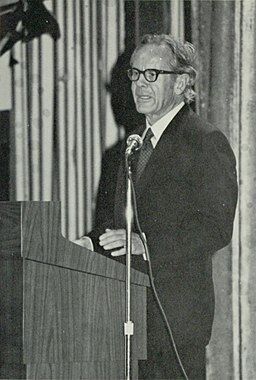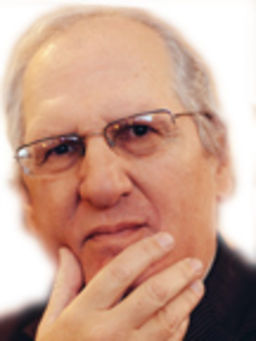Wounded Healer: Rollo May's Psycho-Spiritual Odyssey
Part 4 of a conversation with May biographer Robert Abzug.
Posted Jan 22, 2021

This is Part 4 of my conversation with historian Robert Abzug, whose authorized biography of celebrated psychologist Dr. Rollo May, Psyche and Soul in America: The Spiritual Odyssey of Rollo May (Oxford University Press) will be released on February 1, 2021. (See Part 1 here, and Part 2 here, and Part 3 here.)
DIAMOND: Yes, I remember Rollo referring once privately to the purveyors of "transpersonal" psychology pejoratively as "vultures." Now, in the book, you provide very personal and graphic details regarding May's rocky love life. As you reveal, Rollo came from what we would today call a “dysfunctional” family, in which he was the eldest and favorite son of parents who did not get along, partly due to his absentee father's incessant womanizing. May's sister suffered from psychosis, and Rollo himself suffered as an adult from what may have been sometimes-debilitating symptoms of depression and anxiety. He apparently later felt the need to take care of women emotionally, as he had always done for his emotionally unstable mom and sister.
At the same time, he was, as you describe, extremely dependent on the approval and unequivocal acceptance of women for his self-esteem, and had major difficulty dealing with them--so much so that on several different occasions over the decades he sought, for this and other reasons, the support and professional counsel of various psychotherapists such as his famous training analyst Erich Fromm, Fromm's wife, psychoanalyst Frieda Fromm-Reichman, holocaust survivor and analyst Alberta Szalita, and later, during his 70s, with Joseph Henderson, a senior Jungian analyst and contributing author to Jung's popular book Man and his Symbols in San Francisco. Evidently, based on his childhood history, Rollo had experienced significant narcissistic wounding due to his basic dependency needs having been painfully frustrated and unmet, and formed early on the somewhat grandiose myth, to employ the term May later came to favor, of himself as a special helper of others--first for his siblings and mother, then, in his early 20s, as a religious counselor to college students and later, an ordained Congregational minister, and finally as a practicing psychotherapist, teacher, public speaker, and popular author. Yet, even following his eventual enormous professional success in the world, Rollo reportedly remained defensively aloof from others, resulting in chronic feelings of loneliness, abandonment, and alienation, and wrestled with excruciating feelings of inferiority, insecurity, and self-loathing.
Certainly, we all have our own traumatic experiences, emotional wounds, weaknesses, insecurities, self-defeating patterns of behavior, neurotic complexes, and chronic defense mechanisms. In this regard, Rollo was no different than the rest of us. That is to say, we are all subject to and driven by what he called the “daimonic.” Indeed, Rollo once remarked to me privately that, "The difference between me and other people is that I admit it." The key, as May contends, lies in how we deal with our "daimons" or metaphorical "demons"--destructively or creatively. How, then, in your view as his biographer, did Rollo's persisting painful personal problems and existential life challenges-- starting with his dysfunctional family history and including a youthful “nervous breakdown,” critical battle with tuberculosis during midlife, and two difficult marriages and divorces--play a role in his becoming what he himself referred to as a "wounded healer," and one of the 20th century's most renowned psychologists and psychotherapists?

ABZUG: Great question. Let me answer it in a number of ways. First, I think that his upbringing, so rich in mixed-up love, stress, and expectation, and framed by a Methodist/YMCA expectation of hard work and service, made for a cornucopia of rival and sometimes contradictory demands that created myriad possibilities for a young man of such high intelligence and energy, and much heartache. His upbringing in fact more than qualified him for the title of “wounded healer.” I like what he said to you in private about the difference between him and “other people.” And, of course, his bout with tuberculosis, though a wound of a different order, reminded him of his vulnerability and the importance of "will" to survival. It reminds me of William James’s recovery from his breakdown after visiting the asylum (disguised as a Frenchman in Varieties of Religious Experience), after reading the aptly named French philosopher Renouvier while convalescing.
What I find most fascinating is how actively Rollo used in great detail, but almost always in disguise, his own personal struggles, one or another trauma and temporary resolution, in his early books--The Art of Counseling, The Springs of Creative Living, and, much later, in Freedom and Destiny--a kind of repetition compulsion in print. He kept on going back to the key events in childhood and between Oberlin College and Union Theological Seminary, retelling his story anew over the decades—for different reasons and in different settings. It certainly exemplified his turning the daimonic to creative use, and his becoming a wounded healer.
DIAMOND: Your response prompts yet another question I think PT readers might find of interest: the point you emphasize in the book about Rollo's repeated but covert use of his own conflicts and problems in his books. As we know, May was more openly autobiographical in the much later My Quest for Beauty (1985), but apparently preferred to fictionalize his counselees, clients, or patients in books prior to that, despite having plenty of actual cases to potentially draw upon and discuss. As you say, it appears to have been "a kind of repetition compulsion in print." That is, an unrelenting attempt to resolve and make sense of unresolved conflicts, traumas, and woundedness through self-analysis. Indeed, this sort of verbal repetition and revisiting of traumatic experiences and persisting troublesome symptoms is something that occurs commonly in psychotherapy, and can be seen as part of the process of “working through,” making meaning of, and coming to terms at ever-deepening levels with these profoundly influential and indelible life events. For example, even in Freedom and Destiny, published in 1981, when Rollo was 72, I believe he writes of his doing therapeutic work with a now, as we know, fictionalized patient named Philip dialoguing productively with his own "inner child." (See my prior post.) What do you make of all this? Was the case of Philip based on May’s personal experience in his own therapy?
ABZUG: Another good question. Actually, we only discussed his own use of disguised personal history for earlier examples, where interestingly his resolutions seem to be generated by his self-analysis rather than specifically inspired by incidents in therapy—either his own or that of his clients. It would seem to me that most therapists who include case histories in their books aimed at a popular audience create amalgams from a number of patients, in part to protect confidentiality. Rollo certainly did that in his books. As for the use of autobiographical material hidden by pseudonyms and changes of detail, William James (admittedly not a psychotherapist) was one who used such a device in talking about religious experience and other psychic states. Sigmund Freud, of course, based The Interpretation of Dreams on his own dreams—but with a significant difference: He discussed frankly the choice between using a patient’s or his own dreams, and even noted the limits of such usage.
I think what is also interesting about Rollo May’s use of autobiographical experience is that he told the same basic story numerous times, each time the patient being identified with a different name, life circumstance, and geography. Each time, as well, he created the stories out of fictionalized therapeutic settings. His childhood and the period from college through the 1930s became set pieces of transformation from which he could creatively mold an ever-changing set of lessons. Compare, for instance, Charles of Springs of Creative Living and Philip of Freedom and Destiny. In the fictionalized case of Charles, we see an embrace of Christian faith as the solution, one helped along by therapy but ultimately by his placing his faith in Jesus as “therapist for humanity.” For Philip, he imagined a deep dive back to his traumatic childhood in addition to an account of a mental collapse while in his 20s, this time taking an integrative spiritual cue from Eastern religion. I can’t, in all of literature, think of a similar use of autobiographical material across forty years of writing, with each version of events tailored to a different time and place and new lesson to be drawn.
Which takes us to 1985’s My Quest for Beauty and its first-person rendering of essentially the same story but, as I can attest to from seeing the contemporary sources, closer to the truth than any other account put forth surreptitiously in the earlier versions. Why did he finally reveal the true source of these earlier stories? I can think of a couple of reasons. First of all, Rollo was, in reality, writing a memoir... He had been unsuccessfully trying to write an autobiography for some time, and this was an opportunity to overtly tell at least part of the story. Secondly, by 1985 his age, his own last experience in psychotherapy, and the relative comfort of his relationship with third wife Georgia gave him a somewhat less tortured perspective on his life and opened him to the public telling of the “real” story, albeit with a new mission in mind. Ironically, around the same time he was working on chapters that would eventually become The Cry for Myth, and perhaps realized that the “story” told repeatedly over forty years was a Myth, his own Myth, one that he finally could acknowledge, accept, come to terms with, confess, and take possession of publicly as he contemplated his final years.
Part 5 of this interview appears here.



















